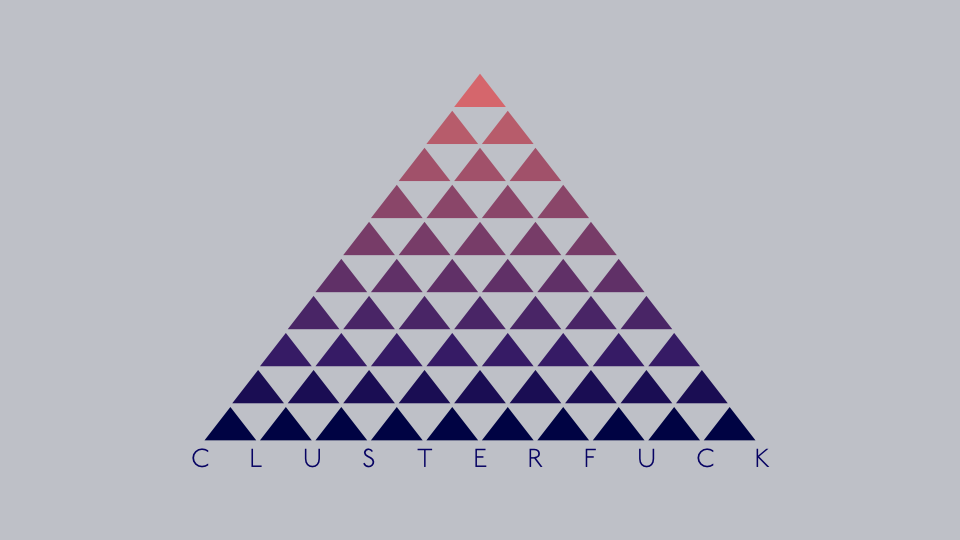A word on UX & IA
Or: how to make sense of anything
Working with UX, information architecture, and content strategy, it’s sometimes hard to make people understand what we’re really doing. That’s partly because these disciplines are young and constantly evolving, and because our ideas about them differ widely. Here’s an attempt at making clear what we talk about when we talk about our work.
In various conversations we had recently, one word somehow always pushed its way forward as we were talking about past projects or having first meetings with our clients. That word is “clusterfuck”.
Want a definition? Thought so:
clusterfuck, n. A chaotic situation where everything seems to go wrong. It is often caused by incompetence, communication failure, or a complex environment.
Synonyms: omnishambles, imbroglio
More often than not, our clients find themselves clusterfucked. Most of the time, they don’t know it yet—they just notice that something is wrong: sales are going down, people have stopped using their service, their competitors have gained ground, etc. But that is, of course, only a symptom of the clusterfuck-disease.
“Incompetence” or “communication failure” sounds very harsh, like someone just did a shitty job and then made a mess of a conversation about it. But it’s not that easy: a clusterfuck situation is where one problem begets another, and changing something about one of them will affect a whole bunch of areas. In a word, it’s complex.
That, however, is not anybody’s fault in particular. Websites, interfaces, and software tend to be entropic, striving towards chaos (even if, or especially when, we throw in more content, features, and functionality over time). And frequently, we’re so terribly immersed in fixing one problem that we don’t notice how chaos has already taken over.
But that’s a big part of UX, IA, and CS: being able to do the right things at the right time, planning why you need what, when, by whom, where it goes and what happens with it. Some of our clients are well aware of that, but there are just so many options and possible actions to be taken that all of this can easily result in clusterfuck. And no, there simply is no easy way to tackle this. There is just the long hard stupid way.
So what we as user experience designers or information architects often do is cleaning up. We take big, complex, overwhelming, unstructured, cluttered, noisy, messy things and re-order them. We take clusterfucks of information, screens, UI components, services, code, ideas, communication structures, discrepancies in metaphors, message and branding and we tidy the shit out of them. We un-clusterfuck.
How?
Every huge problem can be broken down into smaller problems. Then even smaller problems. Until it doesn’t get any smaller or until you have understood the core of one of the problem. You make decisions. Arrange. Re-order. Prioritize. Build small solutions. If you think those solutions are pretty decent, test the hell out of them. Then you build bigger solutions by combining small ones. Out of those, you build one of the best possible solutions within your constraints.
Sounds easy enough? Almost a litte too easy, I’m afraid.
Indeed, because this approach relies exclusively on reduction. As information architect Peter Morville reminds us in his new book Intertwingled, reductionism has worked so well for two-and-a-half millennia that it has blinded us to alternatives. And some problems cannot be solved by reductionism. We also have to think in systems:
“While conventional thinking uses analysis to break things down, system thinking relies on synthesis to see the whole and the interaction between parts.”
—Peter Morville, Intertwingled (p. 16)
Thinking in systems looks at the interrelations, connections, and processes of information; in other words, at its context. So we don’t only have to ask how we can reduce complexity to tackle our clusterfuck problem, but analyze what we analyze, keep our environment in mind, and understand the sum of the parts of a problem.
To close with one of Morville’s key messages: Everyone today must be an information architect in their own right, because it’s a core skill for survival in our information-overload world. Using that word “clusterfuck” made clients suddenly understand that they, too, are UX designers and information architects, albeit on a different level, and they were able relate to our work much more easily. Now, making it your job because you just love to un-clusterfuck is a different matter altogether but that’s essentially what any good information architect or user experience designer is there for.
I sincerely hope to find “un-clusterfucker” in job descriptions in the near future, I want to hear people say that making breakfast was total “omnishambles”, and I wish that “clusterfuck” would make it into the active vocabulary of any project manager, designer, and developer, let alone UX persons or IAs. Sometimes, just one beautiful little word is enough to help people understand a complex process much more easily.


